|
1.
CENTRAL/ WEST AFRICA
Price adjustments
Over the past weeks there have been a few price changes
for both logs and lumber but these are minor adjustments
that have not had a significant impact on the overall
stability of the market.
Sawnwood prices do seem to be a little less firm as
demand in all major markets is still relatively sluggish and
producers believe that demand volumes will remain low
through the European winter months.
Log prices are stable with few changes. Okoume logs are
still in high demand and this is expected to continue.
Padouk logs are selling well to India and China and prices
have increased from a very firm base.
Exporter view
Exporters forecast a steady state in the log market as
demand from Asian markets is good and shows no
immediate signs of change during the remainder of the last
quarter of the year.
The outlook for sawnwood is less well defined. It does not
appear at all likely that West African sawmillers will be
re-opening sawmills or re-starting construction of mills
that are now on hold.
Prospects in Europe
Future prospects for W. African exporters hinge very
much on the European economic situation where the
recent, rather more optimistic, views of the state of the
recovery are appearing to be rather optimistic. The UK,
especially, is set for some hard times in 2010.
Building and civil engineering construction in Europe
show no signs of revival and while the D.I.Y retailing
sector has reported an increase in business, pricing
discounts are now very common and the hardwood timber
business is only a very minor part of this trade.
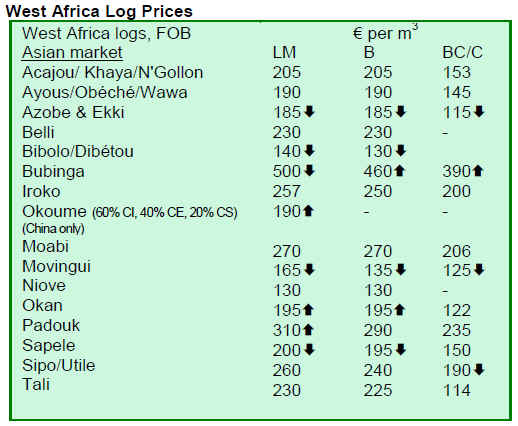
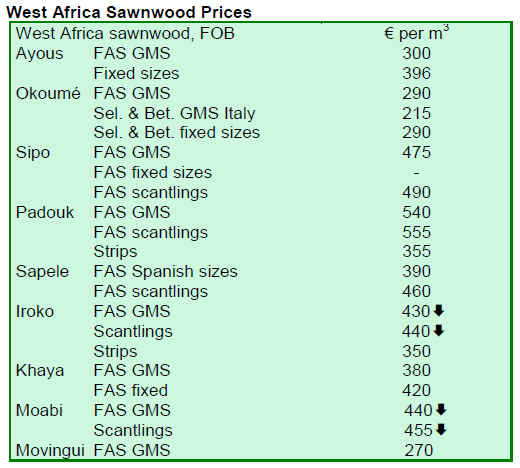
2. GHANA
Growth forecast
Initial reports from the IMF are indicating that Ghana¡¯s
economy will show a moderate growth of 4-5% this year,
in line with earlier forecasts. Stronger gold and cocoa
exports have supported the economy and good weather
conditions have helped the agricultural sector.
The IMF reports that inflation has dropped to around 18
percent in September and points out that the challenge in
2010 will be to tackle Ghana¡¯s rising public debt.
In other news, efforts are underway to strengthen Ghana¡¯s
institutions before the country becomes an oil producer in
2011. Part of this will be the establishment of a single
Ghana Revenue Authority instead of three separate tax
agencies as at present.
Inward investment
Ghana attracted significant new investment in the second
quarter, almost double that of the same period in 2008. A
report by the Ghana Investment Promotion Center showed
that about 80 new projects were registered.
China businesses registered 14 new projects valued at
US$4.98 million while Nigerian investors registered seven
out of the 118 new projects in the first half of the year.
Joint venture projects were valued at around US$75
million, about 30% of the total value of registered projects,
while 100% foreign investments registered were valued at
just over US$30 million.
EPA or not
The risks to Ghana¡¯s exports from not following up on the
EPA (Economic Partnership Agreement) with the EU have
been spelt out by government. The EPAs are a new set of
trade agreements which will allow Europe to export about
80 percent of its products on a duty and quota-free basis to
Ghana, while Ghana will be able to sell products to Europe
duty and quota-free.
Projections are that 40% of Ghana¡¯s exports could be lost
if the country fails to follow through the new trade
agreement with Europe.
With the strong campaign against the EPAs, government is
calling on exporters to allay public fears. The Minister of
Trade has said that the agreement will sustain jobs in the
emerging export sectors as well as in the traditional
sectors.
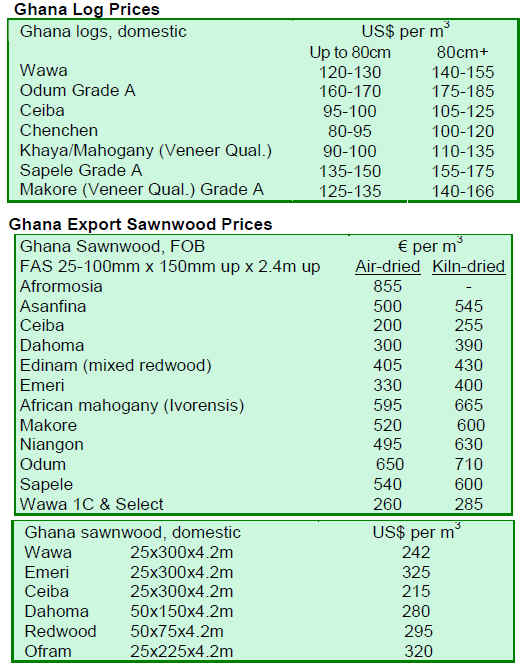
3.
MALAYSIA
Loans for plantations
The Malaysian plantation industries and commodities
minister said that loan agreements with a value of over
RM230 million had been agreed to fund the development
of forest plantations.
Some RM1 billion has reportedly been set aside for this
purpose in the form of soft loans. The government has set
a target of 375,000 ha. of forest plantations to be planted.
SAFODA finance
The Sabah Forestry Development Authority (Safoda) in
East Malaysia became the first Sabah-based company to
obtain finance from the federal government for its forest
plantation programme.
Transparency at work
The Malaysian Auditor-General¡¯s Report for 2008
highlights the illegal activities and poor management
which were the main factors in the reduction of the forest
area in the state of Pahang in West Malaysia. This, says
the report, has contributed to air and water pollution and
the destruction of both flora and fauna habitats in the state.
The report also noted that although over 100,000 ha. of
forest had been earmarked as forest reserve, it took more
than 10 years for the areas to be so gazetted by the state
forestry department.
Middle East construction boom over
Prices of timber products in Malaysia sank to new lows
recently as the impact of a slow down in construction
projects, especially in the Middle-East, hit demand.
Malaysian contractors operating construction projects in
the Middle East are facing considerable difficulties.
High prices for crude oil, which peaked in 2008, resulted
in a building boom in the region but now there are few
new construction projects in the pipeline and contractors
are seeing business fade away.
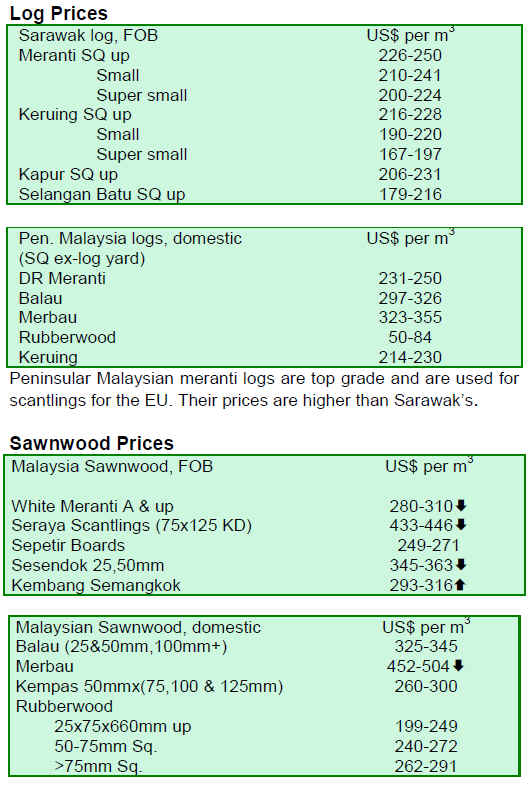
4.
INDONESIA
Stiff penalties
Indonesian authorities now have a framework to address
the degradation of the environment in the form of a
recently passed law. Analysts say that it will take time for
the effects of the implementation to be felt.
Under the law there are stiff penalties, including possible
imprisonment, for executives of companies which breach
the law and the conditions governing their operations.
The Indonesian government has apparently warned all
local authorities to exercise caution when arranging
agreements with carbon credit financing brokers.
Unscrupulous brokers are promising huge profits from
carbon credit trading in the forestry sector and are
reportedly targeting community leaders and municipal
officers in towns and cities.
Export financing support
Indonesia¡¯s Eximbank, a state export financing agency,
has obtained a US$100 million in soft loans from the
Japan Bank for International Cooperation (JBIC) for
exports financing. An additional loan may be provided in
the near future.
The Indonesian trade minister mentioned that the
Eximbank will assist in trade promotion activities for
Indonesian small and medium-sized industries. The
objective is to market Indonesian products in nontraditional
markets such as those in the Middle-East,
Russia and member countries of the CIS.
Eximbank has indicated that it wants to extend around
US$1.90 billion worth of loans in 2010. This would be a
60% jump over the target for 2009.
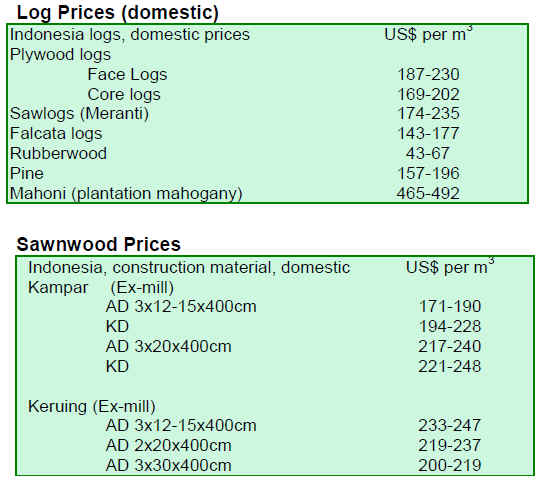
5.
MYANMAR
Market conditions
The Indian market is still buying but there are some
reports that they are doing this to take advantage of a
stronger rupee rather than because of stronger demand.
It is also reported that Indian importers still have
considerably large inventories of material they had
purchased under a stronger dollar. It is only the Indian
market that is holding up for teak while other markets are
weak.
Pyinkado logs are still in demand from Vietnam but there
are reports that shipments have started to slow down.
Shipments of Pyinkado during July and August were over
10,000 tons each month. But they slowed down in
September to about 6,000 tons. So far this October there
has only been one shipment of around 3000 tons. Overall,
the market outlook elsewhere is not good at the moment.
October prices down
Prices at the October auction were down across the board.
There was an almost a 24% drop in SGGG; an 8% drop in
4th Quality logs; a 10% drop in SG1; and an almost 4%
drop in SG2. One regular buyer remarked that the quality
of the lots at the recent auction were very poor, resulting
in lower prices.
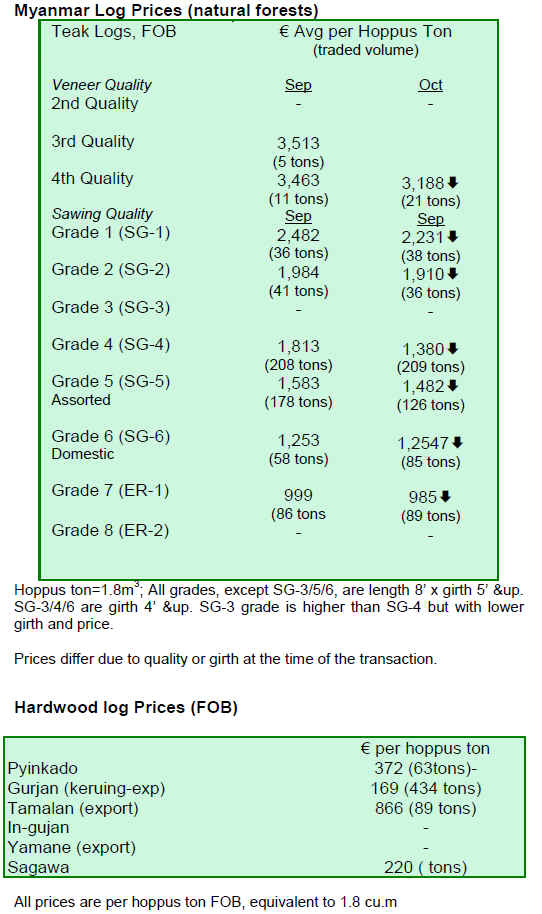
6. INDIA
Buoyant demand for logs
Once again industrial growth figures have reaffirmed that
the Indian economy is rebounding faster than was forecast.
GDP growth for August 2009 was 10.4%, the biggest
jump during the past 22 months.
This economic resurgence stems mainly from strong
domestic demand. The good overall figures are also
reflected in the timber sector.
With the end of the south west monsoon, Government
Forest Depots are busy meeting the demand that springs to
life as soon as the dry season starts.
Auction sales have been announced in Gujarat, central
India and also in southern states. Last seasons¡¯ leftover
stocks are up for sale and fresh log arrivals have also been
brisk.
Demand for sawing quality Teak and Hardwood logs is
good and auction results are expected to be better than the
last time.
Anti dumping duty on MDF.
In response to complaints by the MDF manufacturers that
they were suffering because of the volumes and prices of
MDF from China, Malaysia, Thailand, Sri Lanka and New
Zealand, the Government of India slapped an anti dumping
duty on MDF boards having thickness 6 mm and above.
Details of this are in Customs Notification No.21/2009
dated 27th February 2009.
To determine the duty, floor prices were announced at that
time. Now, with the changed global circumstances and
lower prices from the exporting countries, the floor prices
have been lowered, much to the relief of importers.
Carbon emission reduction
India has signaled that it is willing to act on carbon
emissions and put this in national legislation on reduction
of greenhouse gas emissions, conditional on funding and
technical support from developed countries.
India¡¯s action plan focuses on energy security, unlike
others who concentrate only on emissions reduction.
With abundant sunshine, wind power and biomass
availability, as well as the capacity for additional hydropower,
India has the potential to implement energy
projects with minimal increase in carbon emissions. In
addition to the energy options, improvements can also be
secured through groundwater re-charging, judicious
cropping patterns and practices, and the promotion of
organic farming.
The world is progressing to low-carbon economies and to
manage increased applications for forest clearance the
Indian Ministry of Forests and Environments has called
for the creation of a statutory regulatory body (to be called
the National Environment Protection Authority) that
would manage forest clearance permits and also enforce
regulation.
Plans to increase India¡¯s forest cover from the current 24%
to 33% are in place. Around 9% of the forest cover
comprises degraded forests and efforts are also being
made to improve these to a medium or high density
canopy.
Reportedly, India can save 550 million tons of carbon
dioxide emissions per year by exploring all these
alternatives. Implementation of the current plan will, it is
claimed, attract substantial investments in wind power and
other sources of energy generation.
With 7000 kms of coastline and 216 potential sites
identified, the scope for wind power generation appears
bright.
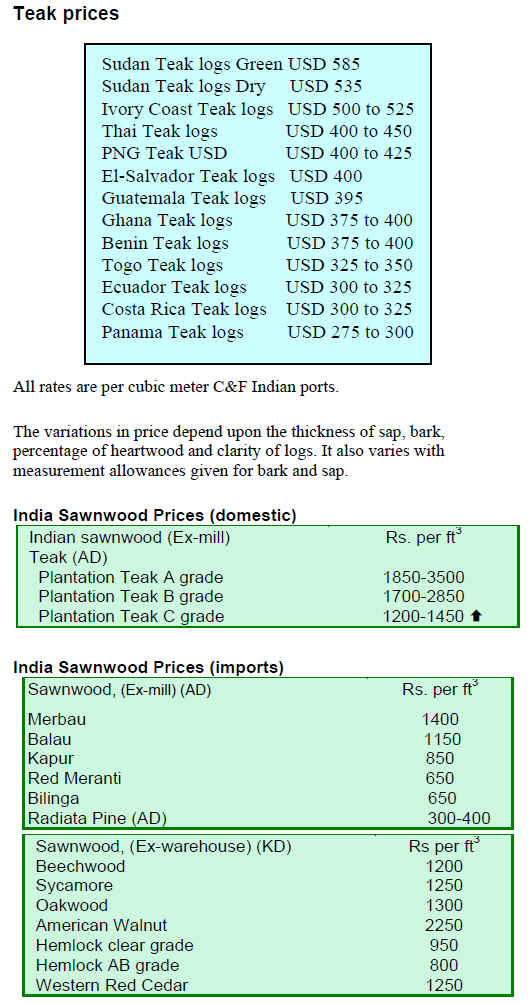
7. BRAZIL
September exports
In September 2009, exports of timber products (excluding
pulp and paper) fell 30.5% compared to September 2008,
from US$ 273 million to US$ 189.6 million.
Pine sawnwood exports dropped by 15% in value in
September 2009 compared to the same month of 2008,
from US$16.3 million to US$13.9 million. By volume,
exports decreased 2.8% from 50,400 cu.m to 49,000 cu.m
over the period.
Tropical sawnwood
Exports of tropical sawnwood also dropped significantly
both in volume and in value terms, from 62,300 cu.m in
September 2008 to 46,600 cu.m in September 2009, and
from US$34.6 million to US$21.9 million, respectively
over the same period. This performance equates to an
overall 25% fall in volume and 37% in value.
Pine plywood exports fell 33% in value in September 2009
compared to the same period of 2008, from US$36.2
million to US 24.1 million. The volume exported was
down almost 20% over the period, from 119,700 cu.m to
96,200 cu.m.
Tropical plywood
A similar picture emerged for exports of tropical plywood
as they were down from 17,700 cu.m in September 2008
to just 10,900 cu.m in September 2009, a 38% fall. In
value terms the picture was even worse with a 45%
reduction recorded over the period, from US$11.3 million
to US$6.2 million.
Exports of wooden furniture fell from US$69.5 million in
September 2008 to US$48.3 million in September 2009,
representing a 30% decrease during the period.
Exporters concerned
The depreciation of the US dollar against the Brazilian
Real has raised concerns among exporters from Rio
Grande do Sul, as any further fall in the dollar would make
their situation even worse.
At the height of the global crisis, the exchange rate of
around BRL 2.40 to the US dollar gave some hope for
recovery in those companies dependent on the external
market.
However, the depreciation of the US$ since the beginning
of the year has made any recovery impossible and has
caused losses in many sectors of the economy.
According to the Industry Federation of Rio Grande do Sul
(FIERGS), exports in the first nine months of 2009
reached US$ 3.4 billion, a 28% fall over the same period
in 2008.
Real appreciates more than others
For entrepreneurs, the main cause of diminishing exports
has been the unfavorable exchange rate. Since January, the
Brazilian Real has appreciated 25% compared with the US
dollar.. This is above the levels observed in most other
countries that export competing products which are traded
in the US currency.
According to the Furniture Industry Association of Rio
Grande do Sul (MOVERGS), the companies operating in
the furniture sector registered a 33.2% fall in exports for
the first eight months of the year compared to the same
period of 2008. It is forecast that there could be a further
fall in exports in the final quarter of the year.
Furniture exports gloomy
The US, UK and France import most of Brazil¡¯s furniture
and all these countries are experiencing weak market
conditions and a consequent cutback in imports.
The only country that expanded its imports was Cuba (up
51% for the year), which accounts for about 2% of the
Brazilian furniture exports.
The US share of Brazilian exports is now about 14% of
total furniture exports, a drop of some 44%. UK imports
from Brazil have fallen by 5.5% between January and
September 2009(Jan ¨C Sept) and now represent just 10%
of the total furniture exports.
The situation in the French market is more serious with
imports from Brazil being down 31%. Currently the
French market takes some 10% of the Brazilian furniture
exports.
Exports from Rio Grande do Sul
The Southern Brazilian state of Rio Grande do Sul has
seen a big drop in furniture exports in the first three
quarters of the year (-33.9%). The UK remains the largest
furniture importer from Rio Grande do Sul, taking around
16% of the total, followed by Argentina (9%), and
Uruguay (8%). The UK imported 13% less during the year
to September 009 compared to the previous year.
Argentina¡¯s imports fell 53% while for Uruguay a modest
increase was recorded. On the other hand Cuba imported
63% more from Rio Grande do Sul during the period
January to September 2009.
The Brazilian furniture exports to Cuba are mostly from
Rio Grande do Sul (US$8.3 million out of a total of
US$8.9 million
Domestic prices
Wood products prices in Brazilian Real (BRL) have
increased marginally (on average 0.16%) since the last
report. Prices in the local market in dollar terms rose by
1.6% due only to the appreciation of the Brazilian
currency against the US dollar.
Economic indicators
The National Consumer Price Index (IPCA) rose 0.24% in
September, following an increase of 0.15% in the month
before.
This result, however, was slightly below the 0.26%
recorded in September 2008, according to the Brazilian
Institute of Geography and Statistics (IBGE).
The Monetary Policy Committee (Copom) of the Central
Bank of Brazil maintained the prime interest rate at 8.75%
per year in a meeting held in early September 2009, and
therefore interrupted the five successive cuts started last
January. The rate is the lowest since its establishment in
1999.
World Cup and Olympics boost
The combined effect of the global crisis, lower domestic
consumption reduction and falling timber exports has
affected the timber sector across Brazil including the
timber industries in the northern region of the Amazonian
state of Mato Grosso.
However, the 2010 World Cup to be held in Brazil (with a
section to be played in Mato Grosso) and the 2016
Olympics has brought some promise that business will
improve. This optimism stems from the view that,
historically, countries that have hosted these events have
all seen an expansion of trade.
The Timber Industry Union of Northern Mato Grosso
(SINDUSMAD) has pointed out that production capacity
and the species available can meet the demands expected
as venues are developed.
Timbers such as Cambara and Amescla and others are
suitable and are abundant in the region. These timbers are
used extensively for making wooden house frames and
roofing components.
The regional timber species are considered to have quality
advantages compared to those from other (southern) states
that may provide materials for the construction work for
the World Cup in Cuiab¨¢ (state capital of Mato Grosso).
Misrepresentations in Maranhao
The state of Maranhão in the Brazilian Amazonia has
adopted IBAMA¡¯s forest origin document as part of the
electronic system for controlling forest products flow
(SISFLORA).
This decision was taken after misrepresentations were
found in documents used by many timber companies that
used the state¡¯s own forest product control system.
An audit has found misreporting of transactions involving
roundwood, sawnwood, fuelwood and other wood
products.
Reports indicate that the auditing exercise found evidence
of misrepresentation by around half of the 1,200
companies registered in the state.
IBAMA said that the approach of Maranhão State is a
good example of the adoption of federal systems for
controlling forest products and that other states such as
Rondônia, Par¨¢ and Mato Grosso should follow this
example.
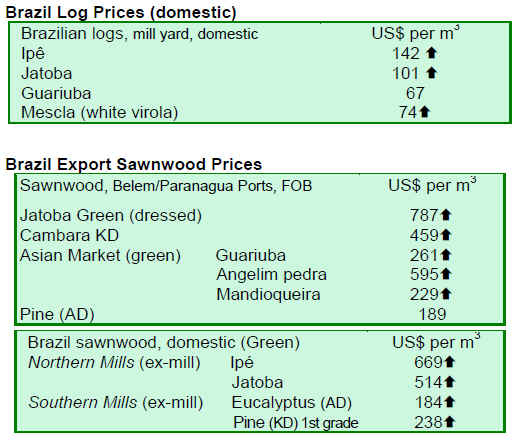
8.
PERU
Economic performance
Peru¡¯s economy has turned out to be one of the strongest
in Latin America since the global recession began, but it
has not been able to avoid a slowing in growth.
The economy contracted in the second quarter 2009 by
1.1% year on year. This was the first quarterly GDP slide
since 2001. The reason for the fall was mainly the decline
in exports particularly of minerals, as well as a steep drop
in domestic investment. However, the economy is not
expected to fall into recession this year.
Timber tracking
Companies in the sector forest, especially those serving
export markets, are trying new timber tracking technology.
Trials are underway in the El Dorado area in the region
Ucayali. This operation was supervised by the forest
authority and representatives of the company involved.
On its way to Lima the trial wood passed 11 check points
to verify the tracking system was working. The bar code
allows rapid identification.
This system of tracking does have opposition and the
president of ADEX's Forest Committee in Santiago has
reportedly questioned the utilization of the barcodes
system as being too expensive.
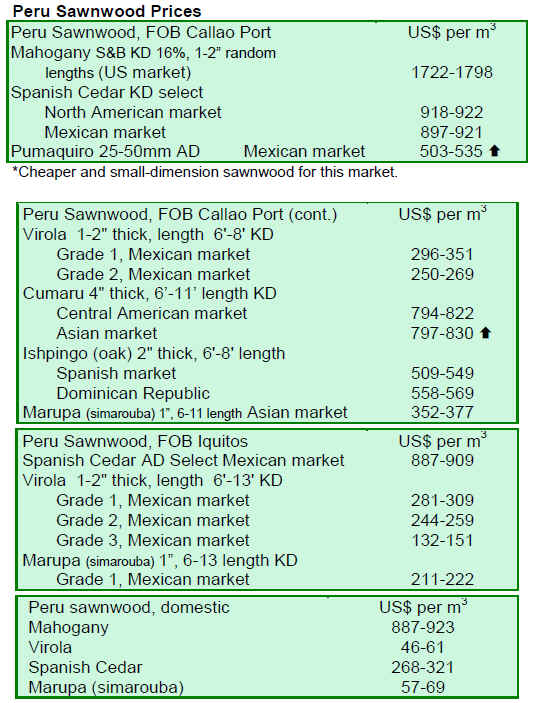
9. BOLIVIA

10. MEXICO
Paying for environmental services
Mexico is developing various mechanisms to stimulate
local markets, attract international funding and
strengthening the current scheme of payment for
environmental services. This is being done to protect
strategic areas for their biodiversity conservation, for
carbon sequestration or for the hydrological services they
provide.
Among the measures to combat climate change the
National Forest Agency (CONAFOR) allocated just over
one billion pesos for the payment for environmental
services. This allowed the incorporation in 2009 of a
further 488,000 hectares to the overall area of 1.9 million
hectares of forests that are currently being supported under
this heading.

Since 2003, when PES was created and up to 2009,
CONAFOR has provided funds to protect a cumulative
total gross area of 2.2 million hectares (ha).
The scheme of payment for environmental services is one
of the instruments CONAFOR developed to promote the
conservation of forests in the country.
Another important tool is the Concurrent Funds, which
seek to establish local PES schemes. In these funds, the
Commission provides up to 50 percent of the amount
required for delivery of these services through a
collaboration agreement in which a counterpart undertakes
to make a contribution at least similar to that of
CONAFOR .
Within the framework of Concurrent Funds, in 2008,
seven agreements were signed with validities ranging from
one to ten years these were worth more than 73 million
pesos and covered about 26,000 hectares.
New international mechanisms
To strengthen efforts to preserve its forest resources,
Mexico is taking steps to attract international funding to
support national needs in the ecosystem services
conservation, such as the mechanism for Reducing
Emissions from Deforestation and Degradation (REDD) ,
which is expected to increase investment for the payment
of these services.
It was against this background that CONAFOR designed
the national strategy for reducing emissions from
deforestation and forest degradation.
Another important tool, promoted by the Federal
Government to strengthen the fight against climate change
from Mexico, is the Biodiversity Endowment Fund. This
was formed as a long-term financing scheme that will help
to preserve forest ecosystems that hold biodiversity of
global importance.
The Fund started with a capital of 130 million pesos from
the Global Environment Fund (GEF) and the Government
of Mexico through CONAFOR. The fund will be slowly
expanded to US$200 mil. in 2025.
This scheme will use only the interest generated by capital
to finance the payment for environmental services for the
conservation and protection of forest areas where there is
biodiversity of global significance.
IMF positive
Six months ago, at the height of the global financial crisis,
Mexico became the first country to secure the first
Flexible Credit Line. The FCL provides insurance against
risks beyond the control of country¡¯s authorities.
In a recent statement the IMF noted that ¡°Despite its
strong policy frameworks, the current global economic
and financial environment has hit Mexico harder than
expected. The economy is in the deepest recession since
the 1994-95 crisis, reflecting especially close links to the
U.S. economy¡±.
The IMF says recent economic indicators show signs of
recovery and overall growth is expected to pick up in the
second half of the year.
11.
Guyana
Market Trends
Prices for logs remain relatively stable, however
Purpleheart small sawmill quality log prices have
increased as they have also for Mora fair and small
sawmill quality logs
Compared to the situation as described in the last report
there was a favourable increase in prices for rough
(undressed) Greenheart sawnwood (USD 852/700), while
Purpleheart rough sawnwood also enjoyed good prices.
Rough Mora prices remain stable. Dressed Greenheart
sawnwood showed a modest price decline in the period of
review but dressed Purpleheart recorded increased prices
for this fortnight period.
Baromalli plywood demand is currently weak and prices
are down.
Value added products such as doors, indoor and outdoor
furniture, mouldings, spindles and non-timber forest
products were notable in their contributions to the export
earnings for the fortnight under review. The Caribbean
remains the primary export destination for value added
products.

FPDMC to China
An invitation to participate in the China Yiwu
(International) Forest Products Fair has been extended to
Guyana by the Vice Mayor of Yiwu City. The FPDMC
will attend.
Yiwu is a city of about 2,000,000 people in central
Zhejiang province near the central eastern coast of China.
The city is famous for its small commodity trade and
vibrant free market.
The FPDMC says this timely invitation will open unique
opportunities for Guyana to promote contacts and utilise
the existing channels for exchanges with a country that
possesses the technology and expertise suitable for
Guyana¡¯s forestry sector.
This event coincides with the recent effort by the Guyana
National Bureau of Standards (GNBS) in collaboration
with Caribbean Regional Organization for Standards and
Quality to introduce standards in the furniture industry.
¡°Promotion Competitiveness in the Furniture Sector¡± was
the theme for a recent workshop whose goal project was to
strengthen the competitiveness of the small and micro
enterprises which make up 80 percent of the total business
sector of Guyana.
The workshop highlighted specific requirements for
furniture manufacturing. These included: Quality;
Moisture Content, Workmanship and Finishing. Standards
as they relate to sanding and application of finishing coats
to furniture during manufacture and sealing of surfaces
were also discussed. Manufacturers and dealers of
furniture have access to detailed furniture standards from
the Guyana National Bureau of Standards.
|